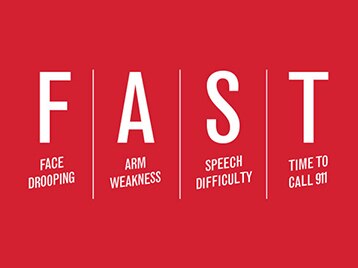Addressing Stroke Risk Factors in People Who Have Diabetes

Stroke is a leading cause of death and disability for people with diabetes. Managing elevated hemoglobin A1C levels, high blood pressure, and high cholesterol can reduce the risk for stroke.
Richard Benson, MD, PhD, is director of the Office of Global Health and Health Disparities at the National Institute of Neurological Disorders and Stroke (NINDS). Here, Dr. Benson discusses the links between stroke and diabetes, and the strategies to reduce stroke risk for people with diabetes.
Q: What is a stroke?
A: There are two major types of stroke. Eighty-seven percent of all strokes are due to ischemia, or decreased blood flow to the brain. This is usually caused by blockage of a blood vessel in the brain, which leads to decreased blood flow. Oxygen is carried by red blood cells, and decreased oxygen to the brain leads to permanent damage of brain tissue. The other 13% of strokes are due to hemorrhage, or bleeding in the brain.
Q: Why is it important to attend to stroke risk in patients with diabetes?
A: Stroke is the fifth most common cause of death and leading cause of disability among adults in the United States. People with diabetes have twice the risk of stroke and worse outcomes than people without diabetes.
Having diabetes puts you at risk for multiple vascular diseases. Vascular diseases are conditions that affect your blood vessels and circulatory system. This can lead to diminished blood flow and formation of clots that can go to the heart or the brain and cause strokes.
People with diabetes tend to have more problems in the smaller arteries. This is called microvascular disease, and it can lead to diminished blood flow in the smaller arteries of the brain, causing strokes. Most strokes are apparent by the clinical findings or by brain imaging using head CT or brain MRI scans. Diminished blood flow in the limbs can lead to amputations and, in the heart, it can cause heart attacks.
Diabetes is also a major risk factor for subcortical white matter disease. This finding is usually noted on brain MRI scans and may be subclinical in nature. However, subcortical white matter disease is associated with cognitive impairment and dementia.
Q: Why does diabetes create higher risk for stroke?
A: Excess glucose in the circulatory system leads to changes in the walls of the small blood vessels, which leads to inflammation and a narrowing and hardening of the arteries, which in turn cuts off the blood supply. You end up with permanent damage in the area supplied by those blood vessels.
Uncontrolled glucose can also damage the arteries of the heart and lead to fatal cardiac arrhythmias. Atrial fibrillation (rapid contraction of the upper chambers of the heart) and a dilated heart can lead to strokes as well. And so uncontrolled diabetes, in addition to impacting the brain directly, can damage the heart, which can indirectly lead to strokes. Thirty percent of all ischemic strokes are related to blood clots from the heart.
Q: How does risk vary across populations?
A: The Northern Manhattan Stroke Study found that stroke was 2 times more common in Black people, and 1.5 times more common in Hispanics, compared to white people.
New strokes occur more frequently in men compared to women. Men, however, tend to have a shorter life expectancy than women, so when you look at stroke prevalence, there are more women in a community at a particular time with stroke, and more women than men dealing with stroke at older ages.
By far, diabetes as a risk factor for stroke is more important in the elderly population. But a younger person with type 2 diabetes, or with uncontrolled type 1 diabetes, can be affected by the sort of damage to the blood vessels that puts one at risk for stroke.
Q: How can health care professionals manage stroke risk in their patients?
A: The important thing is to control risk factors that you can modify. Having an elevated hemoglobin A1C level is a modifiable risk factor for stroke. We also know that prediabetes is an independent risk factor for stroke. If dietary and lifestyle changes don’t make a difference in a patient’s A1C level, there may be a benefit to considering prescribing medicines to control stroke risk.
We know that high blood pressure is highly associated with stroke, and it’s also highly prevalent in our society. One in every two to three adult Americans has hypertension. So it’s important to make sure that blood pressure is under good control.
If someone has elevated cholesterol, statin medicines can help prevent peripheral vascular disease and cardiovascular disease. Studies also show benefits of starting statin agents early in patients after the first stroke.
Other important preventive measures that health care professionals can talk to patients about include stopping smoking, losing weight, increasing physical activity, and moderate alcohol consumption in people who drink alcohol.
Additionally, we know that people who consume five to seven servings of fruit and vegetables per day have a lower risk of stroke compared with people who eat less. Unfortunately, some people don’t have access to fruits and vegetables, have insecure housing and/or transportation, or can’t pay for their food and medicines, or there is some other factor that affects their ability to manage their stroke risk. It’s important for us to try to make sure that people are tied into some type of support that can help them address these social determinants. This is becoming a major consideration in health equity research—how can the medical community address these issues in an effort to provide quality health care? For example, some hospitals now assist people with transportation to doctor visits.

Q: How can health care professionals educate patients on what to do in the event of a stroke?
A: Health care professionals should make sure their patients are aware of the symptoms of stroke (see box). Stroke is an emergency that can be treated if you get immediate medical attention.
Stroke symptoms may sometimes come and resolve quickly, in minutes to hours. This is called a Transient Ischemic Attack (TIA). This is still an emergency. A person with TIA should still report to the emergency room immediately, because the risk of going on to have a major stroke is dramatically increased after a TIA.
Q: What research is being conducted on reducing stroke risk for people with diabetes and decreasing inequities between populations at risk for stroke?
A: The NINDS funded much of the early research on the epidemiology of stroke in various communities. One of these studies is the Northern Manhattan Stroke Study, which I mentioned earlier. Others include the Reasons for Geographic and Racial Differences in Stroke, which is studying approximately 30,000 Black and white participants in the so-called Stroke Belt in the Southeastern United States; the Greater Cincinnati/Northern Kentucky 5 County Area Population-Based Epidemiology of Stroke Study, with a rural and urban study population; and the Brain Attack Surveillance in Corpus Christi study, which is looking at primarily Mexican-American patients with stroke.
We’re also testing some novel interventions. The Hip Hop Stroke Program is a stroke education program using hip hop music to teach the warning signs of stroke and what to do if you see someone having a stroke. That study has shown lasting knowledge retention in middle school kids, and it has documented that the kids share this information with their parents. There have been reported instances of the kids calling 9-1-1 for parents affected by stroke symptoms.
Currently, the NINDS is revamping a public health campaign called Mind Your Risks to address a target audience of Black men ages 28–45. This group is at highest risk for cardiovascular disease. We’re educating study participants about preventing cardiovascular disease and stroke through control of high blood pressure. This is important because uncontrolled blood pressure at younger ages can lead to damage to many organs in the body including the kidneys, the heart, and the brain. Results of the National Institutes of Health-sponsored SPRINT-MIND study revealed a correlation between uncontrolled hypertension and cognitive impairment. Cognitive impairment can be a precursor to dementia.
Lastly, the NINDS is currently developing its strategic plan to address health disparities and health equity. We are looking to scale up and implement across the country best-practice interventions to prevent stroke and manage the complications of stroke and other neurological diseases, particularly those that disproportionately burden certain populations and communities.
Useful Resources
- Stroke and Diabetes chapter, Diabetes in America, 3rd Edition
- Diabetes and Stroke Prevention, American Heart Association
- Prediabetes in Patients with Stroke or Transient Ischemic Attack: Prevalence, Risk and Clinical Management, Fonville S., et al., Cerebrovascular Diseases. 2014;37(6), 393–400.


Comments